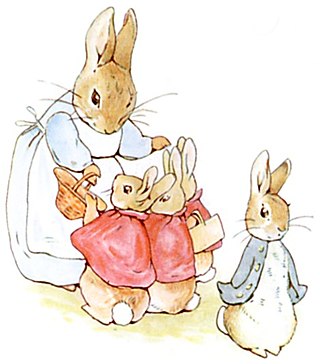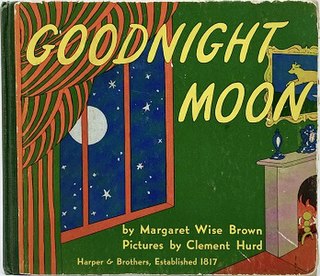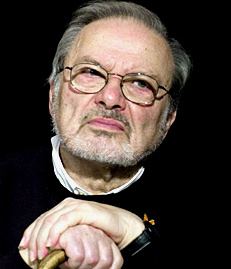Related Research Articles

A picture book combines visual and verbal narratives in a book format, most often aimed at young children. With the narrative told primarily through text, they are distinct from comics, which do so primarily through sequential images. The images in picture books can be produced in a range of media, such as oil paints, acrylics, watercolor, and pencil. Picture books often serve as pedagogical resources, aiding with children's language development or understanding of the world.

Goodnight Moon is an American children's book written by Margaret Wise Brown and illustrated by Clement Hurd. It was published on September 3, 1947, and is a highly acclaimed bedtime story.

Maurice Bernard Sendak was an American author and illustrator of children's books. He became most widely known for his book Where the Wild Things Are, first published in 1963. Born to Polish-Jewish parents, his childhood was affected by the death of many of his family members during the Holocaust. Sendak also wrote works such as In the Night Kitchen, Outside Over There, and illustrated many works by other authors including the Little Bear books by Else Holmelund Minarik.

Margaret Wise Brown was an American writer of children's books, including Goodnight Moon and The Runaway Bunny, both illustrated by Clement Hurd. She has been called "the laureate of the nursery" for her achievements.
Ruth Ida Krauss was an American writer of children's books, including The Carrot Seed, and of theatrical poems for adult readers. Many of her books are still in print.
Little Bear may refer to:

Little Bear, also known as Maurice Sendak's Little Bear, is a Canadian children's animated television series produced by Nelvana Limited in association with the Canadian Broadcasting Corporation. It is based on the Little Bear series of books, which were written by Else Holmelund Minarik and illustrated by Maurice Sendak. In the United States, the show premiered on Nickelodeon as part of the Nick Jr. block on November 6, 1995, until the final episode aired on June 1, 2001. The show also aired on CBS on Saturday mornings from September 16, 2000, until September 15, 2001.

Little Bear is a series of children's books written by Else Holmelund Minarik and primarily involving the interaction of Little Bear, an anthropomorphic cub, and Mother Bear, his mother.
Else Holmelund Minarik was a Danish-born American author of more than 40 children's books. She was most commonly associated with her Little Bear series of children's books, which were adapted for television. Minarik was also the author of another well-known book, No Fighting, No Biting!

Pura Teresa Belpré y Nogueras was an Afro-Puerto Rican educator who served as the first Puerto Rican librarian in New York City. She was also a writer, collector of folktales, and puppeteer.

Danny and the Dinosaur is a children's picture book by Syd Hoff, first published by Harper & Brothers in 1958. It has sold over ten million copies and has been translated into a dozen languages. The book inspired six other sequels by Syd Hoff. Danny and the Dinosaur is designated as an I Can Read! Book.
Beatrice Schenk de Regniers was an American writer of children's picture books.
Ursula Nordstrom was publisher and editor-in-chief of juvenile books at Harper & Row from 1940 to 1973. She is credited with presiding over a transformation in children's literature in which morality tales written for adult approval gave way to works that instead appealed to children's imaginations and emotions.

If I Had My Way is a 1940 musical comedy film directed by David Butler and starring Bing Crosby and Gloria Jean. Based on a story by David Butler, the film is about a construction worker who takes charge of the daughter of a friend killed in an accident.

Maurice Sendak's Little Bear: The Little Bear Movie, or simply The Little Bear Movie, also known as Maurice Sendak's Little Bear: The Movie or simply Little Bear: The Movie, is a 2001 Canadian-American direct-to-video children's animated adventure film directed by Raymond Jafelice who co-wrote the screenplay with James Still and Nancy Barr. It is based on the Canadian children's animated television series Little Bear, which in turn is based on the children's book series of the same name written by Else Holmelund Minarik and illustrated by Maurice Sendak.

Weston Woods Studios is a production company that makes audio and short films based on well-known books for children. It was founded in 1953 by Morton Schindel in Weston, Connecticut, and named after the wooded area near his home. Weston Woods Studios' first project was Andy and the Lion in 1954, and its first animated film was The Snowy Day in 1964. In 1968, Weston Woods began a long collaboration with animator Gene Deitch. Later, they opened international offices in Henley-on-Thames, England, UK (1972), as well as in Canada (1975), and in Australia (1977). In addition to making the films, Weston Woods also conducted interviews with the writers, illustrators, and makers of the films. The films have appeared on children's television programs such as Captain Kangaroo, Eureeka's Castle, and Sammy's Story Shop. In the mid-1980s, the films were released on VHS under the Children's Circle titles, and Wood Knapp Video distributed these releases from 1988 to 1995.

David T. Wenzel is an illustrator and children's book artist. He is best known for his graphic novel adaptation of J.R.R. Tolkien's The Hobbit.
Purple House Press is a publishing house based in Cynthiana, Kentucky. Founded in 2000 by former software engineer Jill Morgan, it specializes in bringing out-of-print children's books back into print.
W. R. Scott was a children's literature publisher based in New York City that specialized in visually striking books with a contemporary educational philosophy. W. R. Scott's first editor was Margaret Wise Brown; the company also published a number of her books.
Arnold Lobel was a children's author and illustrator. He wrote:
References
- ↑ Alverson, Brigid (8 October 2020). "HarperCollins Launches I Can Read! Comics". Publishers Weekly. Retrieved 9 October 2020.
- ↑ "The History of I Can Read!". I Can Read! Website. Harper Collins. Archived from the original on 2010-05-25. Retrieved 2010-07-03.
- "Biscuit Goes to School" by Alyssa Satin Capucilli; pictures by Pat Schories. Fiction, 26 pages. HarperCollins Publishers, 2002. ISBN 978-0-06-443616-8.